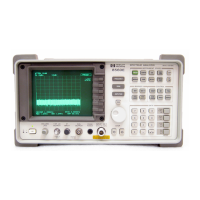538 Chapter10
Synthesizer Section
Unlocked YTO PLL
Unlocked YTO PLL
Operation
The A11 YTO is locked to two other oscillators: the fractional N
oscillator, and the offset PLL sampling oscillator. For LO spans of 2.01
MHz and greater, either the FM or main coil of the YTO is swept
directly. For LO spans of 2 MHz and less, the fractional N oscillator is
swept. The sampling oscillator remains fixed-tuned during all sweeps.
The output of A11 YTO feeds through the A7 LO distribution amplifier
(LODA) to the A15U100 sampler. The offset PLL sampling oscillator,
which drives the sampler, oscillates between 285 and 297.222 MHz. The
sampler generates harmonics of the sampling oscillator and one of
these harmonics mixes with the YTO frequency to generate the sampler
IF frequency. As a result, the frequency of the sampler IF is determined
by the following equation:
Where:
—F
IF
is the sampler IF
—F
YTO
is the YTO frequency
— N is the desired sampling oscillator harmonic
—F
SAMP
is the sampling oscillator frequency
Notice that F
IF
can be positive or negative depending upon whether
the sampling oscillator harmonic used is less than or greater than
the YTO frequency. The actual sampler IF is always positive, but the
sign is carried along as a "bookkeeping" function which determines
which way to sweep the fractional N oscillator (up or down) and
what polarity the YTO error voltage should have (positive or
negative) to maintain lock.
To check if a negative sampler IF is selected, press
CAL, MORE 1 OF
2, FREQ DIAGNOSE, FRAC N FREQ. If the fractional N oscillator
frequency is positive, the sampler IF is also positive. A negative
fractional N frequency indicates that the sampler IF is negative.
Notice that the polarity of the YTO loop error voltage (YTO ERROR)
out of the YTO loop phase/frequency detector changes as a function
of the polarity of the sampler IF. That is, for positive sampler IFs, an
increasing YTO frequency results in an increasing YTO ERROR
signal. For negative sampler IFs, an increasing YTO frequency
results in a decreasing YTO ERROR signal. This implies that to
maintain lock in both cases, the sense of YTO ERROR must be
F
IF
F
YTO
NF
SAMP
×()–=

